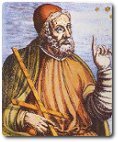The Wife of Bath's Prologue and Tale Contents
Part four: l.163 'Up sterte' - l.192 'For myn entente'
Synopsis of l.163-192
The Pardoner starts up, and the Wife puts him down
The Pardoner manages to get a word in here with a comment about his intention to marry, about which he is now having second thoughts. The Wife assures him that he will find out a great deal more about tribulation in marriage when she comes to tell her tale, i.e. of her own behaviour in marriage. The Pardoner asks the Wife to continue so that her hearers can learn from her techniques. The Wife is happy to continue, claiming that her intentions are playful and fanciful. She hopes the company will not be offended by her speech. (See Narrative > The portrait of the Wife of Bath in The General Prologue > The gaps in the text)
Commentary on l.163-192
The Pardoner's interruption is a joke. Chaucer's Pardoner, described in the General Prologue to The Canterbury Tales, from l.679, is unlikely to marry:
- His appearance is alarming
- He has staring eyes and dishevelled long hair
- He lacks a beard and has a voice like a goat
- He may not be heterosexual. (See The Pardoner's Prologue and Tale > Characterisation in The Pardoner's Prologue and Tale > The Pardoner.)
The Pardoner's interruption is comic, but he has seen aspects of a fellow practitioner in the Wife; he jokingly identifies her as a preacher – ‘Ye ben a noble prechour …'
l.164: dame … by seint john!: The Pardoner may be ironic in calling the bawdy Wife ‘my lady'. If he is alluding to St John the Evangelist (an evangelist is someone who spreads good news), that may also refer to the Wife's willingness to share her libido.
l.165 Ye been a noble prechour: Only men were allowed to preach or officiate in the medieval church, but the Pardoner appreciates that the Wife has employed the kind of tactics / style that he himself would use. (See Literary context > Medieval literary conventions and The Wife of Bath's Prologue and Tale.)
l.170,177 drynken of another tonne / … ale: The Wife's earthiness is portrayed by the metaphors she employs. Earlier she described herself as rough barley bread. Here the analogy is with  a barrel of rough beer.
a barrel of rough beer.
l.182 The same wordes writeth ptholomee: Any good medieval sermon would refer to ‘auctoritee's. Here the Wife alludes to Ptolemy, a Greek scholar and astrologer banned by the church.
l.190 If that I speke: The Wife sets out her intentions in telling the tale of her marriages. Her aim is not to offend but to entertain according to her fancy. Think about whether this alters the way in which we interpret the rest of her Prologue. Is the fictional Wife creating another fiction?
Investigating l.163-192: Chaucer's use of caesura
- A caesura is a break within a line of poetry. There is a strong break in l.166 after ‘wyf'. Editors make different choices about how to punctuate this, but even without punctuation there would be a sense of pause between ‘wyf' and ‘allas'. What effect does this pause have on your interpretation of the line?
- Does it make the Pardoner's claim more dramatic?
- Does it provide a pause in which the listener's responses can be registered, e.g. in shock or laughter?
Related material
Scan and go

Scan on your mobile for direct link.